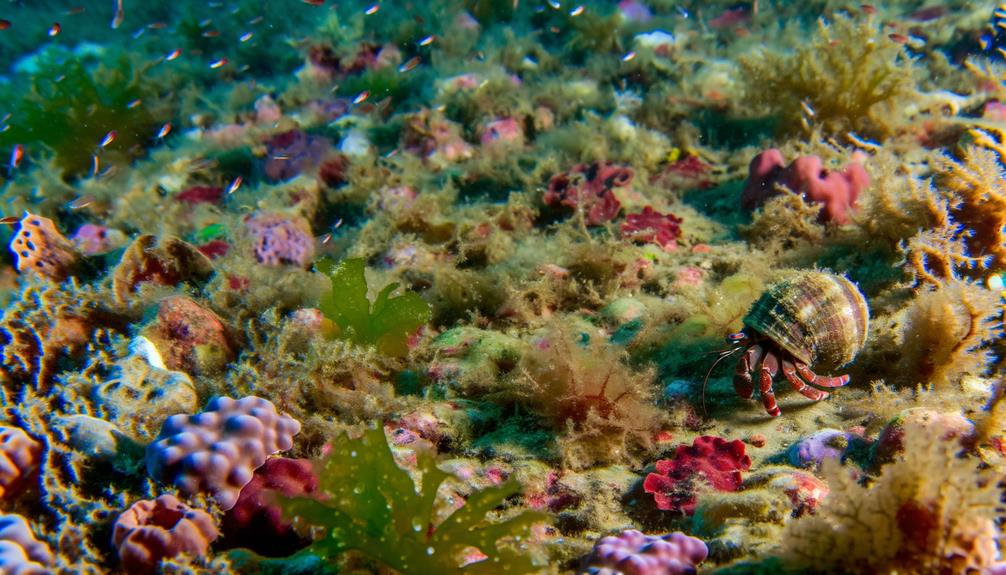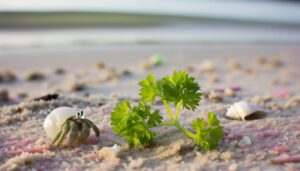How Do Hermit Crabs Outgrow Their Shells?
Yes, hermit crabs need water, but not specifically to swim in. They require both freshwater and saltwater for hydration, respiration, and shell maintenance.
Hermit crabs' modified gills need moisture to function correctly. Freshwater should be dechlorinated, and saltwater should have the appropriate salinity using a marine-grade salt mix.
The water dishes should be shallow and non-metallic to avoid rust. Proper hydration helps with molting and overall health.
Ensuring a balanced and clean water environment is essential for their well-being. For more detailed information, let's move forward.

Key Takeaways
- Hermit crabs need water for hydration, respiration, and molting.
- Both freshwater and saltwater are essential for hermit crabs' overall well-being.
- Providing water dishes allows hermit crabs to submerge and swim.
- Proper water quality and salinity levels are crucial for hermit crabs' health.
- Observing swimming behavior indicates physical health and natural activity.
Hermit Crab Habitat Needs
Why do hermit crabs need both land and water environments to thrive?
You need to understand that hermit crabs are dual-dwelling creatures. They spend time on land for activities like foraging and socializing, but they also need water for essential biological functions. Specifically, they use marine or brackish water to maintain proper hydration and support respiration through their modified gills.
Without access to both land and water, hermit crabs can't regulate their internal environment effectively. Providing a habitat that includes both terrestrial and aquatic elements ensures they can perform vital functions like molting, feeding, and excreting waste.
Creating this balanced environment is vital for their overall health and longevity, enabling you to care for them more effectively.
Importance of Water
Understanding the significance of water for hermit crabs involves recognizing how it supports their physiological processes like hydration, respiration, and excretion. Water is essential for maintaining their overall health.
Hermit crabs use water to moisten their gills, which are necessary for breathing. Without adequate moisture, their gills can become dry, leading to respiratory issues. Additionally, water aids in their excretion process, helping them remove waste efficiently.
To ensure your hermit crabs thrive, you must provide a consistent water source. They need it not just for drinking but also for replenishing their shells with humidity. Proper hydration maintains their electrolyte balance, vital for muscle function and overall wellness. Your commitment to providing clean water directly impacts their well-being.
Freshwater Vs. Saltwater
When considering hermit crabs' water needs, you must distinguish between freshwater and saltwater requirements.
Freshwater habitat supports specific species that don't tolerate high salinity, while saltwater habitat is essential for marine hermit crabs.
Understanding these differences guarantees ideal care and environmental conditions for your hermit crabs.
Freshwater Habitat Requirements
Hermit crabs need specific water conditions to thrive, and it's vital to understand the differences between freshwater and saltwater environments.
For freshwater habitats, make sure the water is free of chlorine, as chlorine can be harmful. Use dechlorinated tap water or spring water. Freshwater should be shallow, allowing the crabs to partially submerge without difficulty. Maintain clean water by changing it regularly to prevent bacterial build-up.
Monitor temperature, keeping it between 72-80°F, and ensure the humidity level stays around 70-80%. Freshwater provides necessary hydration and aids in molting processes. It's important to provide a consistent, safe environment to promote the well-being of your hermit crabs. Always prioritize the meticulous care of their freshwater needs.
Saltwater Habitat Necessities
How do saltwater requirements differ from freshwater needs when caring for hermit crabs? Hermit crabs need both freshwater and saltwater for survival. Saltwater, mimicking their natural marine environment, is essential for their overall health. You must prepare it using marine-grade salt mix to achieve the correct salinity level, around 1.021 to 1.026 specific gravity. This ensures proper osmoregulation, aiding in moisture retention and shell maintenance.
In contrast, freshwater doesn't require specific salinity but must be dechlorinated to avoid harmful chemicals. Use water conditioners or let tap water sit for 24 hours. By providing both types, you help hermit crabs regulate their internal fluids and maintain a healthy shell. Balancing these water needs is crucial for their well-being.
Setting Up Water Dish
To set up the water dish for your hermit crabs, it's important to consider several factors. Make sure the dish is shallow enough for easy access but deep enough for them to submerge slightly. Choose a dish with a gradual slope to prevent drowning risks and use a non-metallic material to avoid rust and corrosion. Add smooth, flat stones or marbles to provide footing and reduce slipping hazards. Regularly clean the dish to prevent bacterial buildup and ensure fresh water is available at all times. Position the water dish in a stable and accessible area within the habitat. By following these steps, you can create a safe and functional water source that effectively meets your hermit crabs' needs.
How Much Water
With the water dish set up, determining the precise amount of water needed is the next step. You should make sure the water level is shallow enough for the hermit crab to stand in without being fully submerged but deep enough for them to partially immerse themselves. Aim for a depth of about 1-2 centimeters.
Monitor the water level regularly to prevent it from becoming too low or too high. Consistent water depth is crucial; it helps maintain a stable environment and minimizes stress for your hermit crabs.
Additionally, use dechlorinated water to avoid any harmful chemicals. By maintaining the correct water level, you'll create an ideal habitat, promoting the health and well-being of your hermit crabs.
Swimming Behavior
Hermit crabs display captivating swimming behavior, often using their limbs to propel themselves through shallow water. You'll notice they rely on their pleopods, small appendages located on their abdomen, for movement. These pleopods enable them to navigate efficiently, allowing precise control over their direction and speed.
Additionally, their chelae, or claws, can act as stabilizers, helping to maintain balance and prevent tumbling.
Observing their swimming can provide valuable insights into their physical health and overall well-being. Healthy hermit crabs will exhibit coordinated and purposeful movements, indicating robust muscular development and proper hydration.
If you're caring for hermit crabs, ensuring they've access to suitable water environments for swimming can greatly enhance their quality of life and natural behaviors.
Aquatic Vs. Land Hermit Crabs
You need to understand the distinct habitat and adaptation differences between aquatic and land hermit crabs. Aquatic hermit crabs require a fully submerged environment and possess gills for underwater respiration, while land hermit crabs need humid air and access to both fresh and saltwater for hydration.
Comparing their water requirements reveals critical insights into their survival and care needs.
Habitat and Adaptation Differences
Aquatic and land hermit crabs exhibit distinct habitat preferences and physiological adaptations that enable their survival in different environments. Aquatic hermit crabs thrive in saltwater, often inhabiting coastal regions and tidal pools. They possess gills adapted for extracting oxygen from water.
In contrast, land hermit crabs require humid environments to keep their modified gills moist, essential for breathing air. You'll find them in tropical areas, often near the shoreline. Aquatic species have streamlined bodies for swimming, while land hermit crabs have stronger legs for terrestrial mobility.
Both types depend on shells for protection, but their adaptive differences are critical for their respective habitats. Understanding these distinctions enables you to better cater to their specific care needs, ensuring their well-being.
Water Requirements Comparison
Water requirements for aquatic and land hermit crabs differ significantly due to their distinct physiological adaptations and environmental needs. Aquatic hermit crabs, like those in marine environments, need saltwater to survive. They rely on it for respiration through their gills and for maintaining osmotic balance. You'll need to provide a saltwater aquarium, making sure the water's quality and salinity are best suited.
In contrast, land hermit crabs require both freshwater and saltwater for drinking and bathing to keep their gills moist. They can't swim and will drown in deep water. You should provide shallow dishes with dechlorinated water and marine-grade saltwater.
Understanding these differences helps you meet their specific hydration needs, which is essential for their well-being.
Signs of Dehydration
Often, hermit crabs exhibit dehydration through lethargy, a dry exoskeleton, and reduced activity levels. You might notice your hermit crab moving less or staying in one spot for extended periods. Their exoskeleton may appear dull or flaky, indicating a lack of moisture.
Reduced appetite and decreased interaction with their environment are additional warning signs. To maintain your hermit crab's health, closely monitor these symptoms. Immediate action is required if dehydration is suspected, as it can lead to severe health issues or even death.
Regularly check the humidity levels in their habitat and make sure they've access to both fresh and saltwater for hydration needs. Your vigilance can make a significant difference in their well-being.
Maintaining Water Quality
To maintain the best water quality for your hermit crabs, regularly change the water to prevent contamination.
Monitor salinity levels closely, as they're essential for the crabs' health.
Implementing a reliable filtration system can greatly reduce impurities and secure a stable aquatic environment.
Regular Water Changes
Performing regular water changes is essential for maintaining ideal water quality in a hermit crab's habitat. You'll need to monitor the water parameters closely and replace a portion of the water weekly. This helps prevent the buildup of harmful substances like ammonia and nitrites, ensuring a safe environment for your crabs.
Here's a simple schedule to follow:
| Frequency | Amount to Change | Notes |
|---|---|---|
| Daily | Top off evaporated water | Use dechlorinated water |
| Weekly | 25% | Check for ammonia, nitrites |
| Monthly | 50% | Deep clean tank and substrate |
Salinity Levels Importance
Maintaining the correct salinity levels is vital for the health and well-being of your hermit crabs. You must guarantee the water mimics their natural ocean environment, which typically has a salinity of 1.022 to 1.025 specific gravity. Use a hydrometer or refractometer to measure this precisely.
Inaccurate salinity can lead to stress, molting issues, and even death. Regularly check and adjust the salinity to maintain stability. Mixing marine salt with dechlorinated water is necessary for optimal outcomes. Don't use table salt or other non-marine salts, as they lack essential minerals.
Filtration Systems Benefits
Ensuring excellent water quality for your hermit crabs also involves using effective filtration systems. These systems remove harmful toxins, debris, and uneaten food, preventing water contamination. By maintaining a clean environment, you enhance your hermit crabs' health and longevity. Here's a comparison of common filtration methods:
| Filtration Type | Benefit |
|---|---|
| Mechanical | Removes physical debris |
| Chemical | Eliminates toxins and odors |
| Biological | Promotes beneficial bacteria |
Mechanical filters trap particles, while chemical filters neutralize harmful substances. Biological filtration fosters beneficial bacteria that break down waste, creating a balanced ecosystem. Choosing the right filtration system means a healthier habitat for your hermit crabs, enabling them to thrive and swim comfortably.
Water Temperature
Ideal water temperature is crucial for hermit crabs' physiological functions and overall health. You should maintain the water temperature between 72°F and 82°F (22°C to 28°C). This range supports proper metabolic activity, hydration, and molting processes.
If the water is too cold, hermit crabs can become lethargic and stressed, potentially leading to health issues. Conversely, excessively warm water can cause overheating, dehydration, and stress.
Use a reliable aquarium thermometer to monitor the temperature precisely, ensuring it stays within the ideal range. You might need a heater or cooling system, depending on your climate.
Regularly check and adjust the equipment to maintain the best-suited environment. By doing so, you'll guarantee your hermit crabs thrive in a stable, healthy habitat.
Bathing Hermit Crabs
Bathing your hermit crabs is crucial to their health, helping to remove debris, mites, and other contaminants from their exoskeletons.
To effectively bathe them, prepare a shallow dish of dechlorinated water. Confirm the water level is low enough to prevent drowning but sufficient for soaking. Gently place the hermit crab in the water, allowing it to wash itself. Use a soft brush if manual cleaning is necessary, but be careful to avoid damaging their delicate exoskeleton.
Bathing should be done once a week, maintaining consistency without overdoing it, as excessive bathing can cause stress. After bathing, make sure they're completely dry before returning them to their habitat to prevent mold and bacteria growth.
Common Water Mistakes
While proper bathing techniques are important, it's equally critical to avoid common water mistakes that could harm your hermit crabs. Ensure you don't use chlorinated tap water, as the chemicals can be toxic. Always dechlorinate the water before use. Avoid using cold water; hermit crabs need water at a temperature of 72-80°F. Don't overfill the water dish; it should be shallow enough for your crabs to easily climb in and out. Lastly, never neglect to clean the water dish regularly to prevent bacterial build-up.
| Mistake | Consequence |
|---|---|
| Using chlorinated water | Toxicity and health issues |
| Cold water | Stress and sluggish behavior |
| Overfilled dish | Risk of drowning |
| Unclean dish | Bacterial infections |
Additional Care Tips
To maintain your hermit crabs thrive, sustain ideal humidity levels between 70% and 80% within their habitat. Use a hygrometer to monitor this closely, as low humidity can cause respiratory issues.
Assure the substrate is deep enough—around 6 inches—to allow for burrowing, which is essential for molting. Provide both fresh and saltwater pools, using dechlorinated water, to meet their hydration needs.
Regularly clean the habitat to prevent bacterial growth. Offer a balanced diet comprising commercial hermit crab food, fresh fruits, and vegetables. Supplement with calcium sources like cuttlebone. Avoid overcrowding to reduce stress and potential for territorial disputes.
Conclusion
In ensuring your hermit crab's well-being, remember that both freshwater and saltwater are crucial. Curiously, studies show that hermit crabs can live up to 30 years in captivity with proper care. This underscores the significance of meticulous attention to their habitat needs, including water.
Set up suitable water dishes, maintain optimal temperatures, and avoid common mistakes. By doing this, you'll notably improve their quality of life and longevity, turning your pet care into a fulfilling experience.





